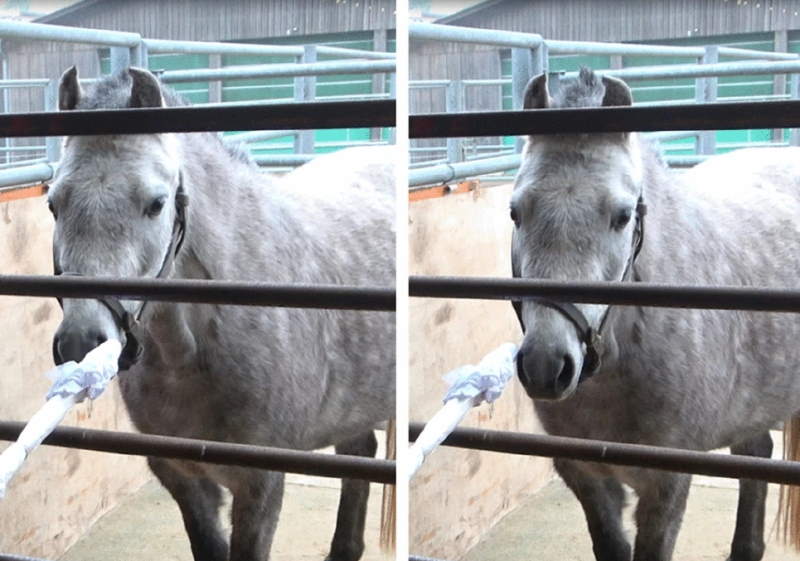Horses are able to discriminate between human odors produced in times of fear and joy, researchers in France report.
The findings, reported in the journal Scientific Reports, indicate that smell can be added to hearing and vision as senses through which horses can perceive human emotions.
Plotine Jardat and her fellow researchers said animals are widely believed to sense human emotions through smell. Indeed, chemoreception is the most primitive and common sense, and brain regions responsible for processing smells are among the oldest structures in mammalian evolution.
The researchers in the University of Tours study said chemosignals might also be involved in communication between species.
“The communication of emotions is essential for social interactions, but very few studies have clearly shown that animals can sense human emotions through smell,” they said.
In their study, the researchers used a habituation-discrimination protocol to test whether 30 Welsh mares could discriminate between human odors produced while feeling fear versus joy.
The odors used were armpit sweat, collected from 15 adults who watched two 20-minute videos, one of which provoked fear (a horror movie excerpt) and the other joy. The participants were asked to eat nothing strong for two days beforehand which might influence their sweat, such as garlic or blue cheese, and wore unscented T-shirts for the experiment.
Under the protocol, the horses were exposed to one of the collected odors on a piece of fabric at the end of a wooden stick in a small pen. In the habituation phase, each horse was presented with the odor for two minutes, which they were allowed to sniff. A minute later, a second sample of the same odor was presented for another two minutes.
Then, after another minute lapsed, two samples were presented to the horses on sticks, 50cm apart. One carried a third sample of the original odor, and the other carried a sample collected from the opposite emotion. At this point, each horse was exposed to two odors from the same human in the fear or joy condition.
Of the 30 horses, five did not sniff any of the samples during the habituation phase and were therefore excluded from further analysis.
The study team found that the horses sniffed the novel odor longer than the repeated odor, indicating they discriminated between human odors produced in fear and joy contexts.
“When the repeated odor and the novel odor were presented simultaneously during the discrimination phase, horses preferentially used their left nostril to sniff the repeated odor and their right nostril to sniff the novel odor.
“This finding is consistent with the previous observation that horses preferentially used their right nostril for sniffing novel objects, and it supplies additional evidence that horses differentiated between the two odors,” the authors wrote.
“If horses can perceive the emotional odors of humans, this raises the question of what compounds are the chemical basis for such interspecific communication.”
In humans, several compounds in sweat, such as adrenaline or androstadienone, have been proposed as candidates that carry emotional information.
The perception of human emotional information contained in sweat odors implies the existence of receptors for such compounds.
“These receptors could be present in horses, either as a result of domestication or by inheritance from a common mammalian ancestor.”
Smell, they noted, is the most ancient and universal sense, and the cerebral structures that process odors evolved very early in mammals. The evolutionary hypothesis is also supported by the recent finding that humans could recognize fear and non-fear odors in horse sweat, which could occur through the existence of common chemical compounds and their receptors in all mammals.
The fact that the horses used their left nostril significantly more than their right nostril during the habituation phase suggests they explored these human body odors with a left hemisphere bias.
“Such bias is usually observed when exploring positive or familiar stimuli in domestic mammals; thus, these results indicate that the horses in this experiment perceived human body odors as positive or familiar stimuli, which can be explained by an overall positive relationship with humans.”
In contrast, the horses used their right nostril significantly more than the left in the discrimination phase.
“It is possible,” they said, “that after recognizing in the habituation phase that the two samples were produced in the same emotional state by the same person, horses were somewhat surprised by the different emotional state they smelled in sample B.
“Indeed, other studies found the right hemisphere to be preferred for the evaluation of novel stimuli and situations that may request quick reactions,” they said.
“In this study, we showed in habituation-discrimination tests that horses can discriminate between human odors produced in a joy versus fear context.
“Moreover, differences in habituation speed and asymmetric nostril use according to odor suggest differential emotional processing of the two odors.
“This study adds olfaction to audition and vision as senses through which horses perceive human emotions and may be influenced by them.”
The study team comprised Jardat, Alexandra Destrez, Fabrice Damon, Zoé Menard-Peroy, Céline Parias, Philippe Barrière, Matthieu Keller, Ludovic Calandreau and Léa Lansade, variously affiliated with the University of Tours, the French National Centre for Scientific Research (CNRS), the agricultural research agency INRAE, and the French Institute of the Horse and Riding (IFCE)
Jardat, P., Destrez, A., Damon, F. et al. Horses discriminate human body odors between fear and joy contexts in a habituation-discrimination protocol. Sci Rep 13, 3285 (2023). https://doi.org/10.1038/s41598-023-30119-8
The study, published under a Creative Commons License, can be read here.
Source: Horses show ability to discriminate between human odors of fear and joy – Horsetalk.co.nz













